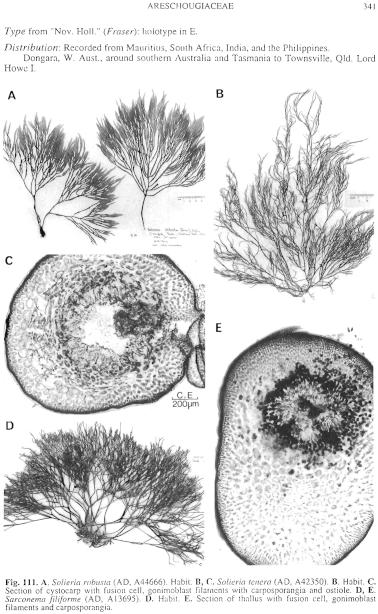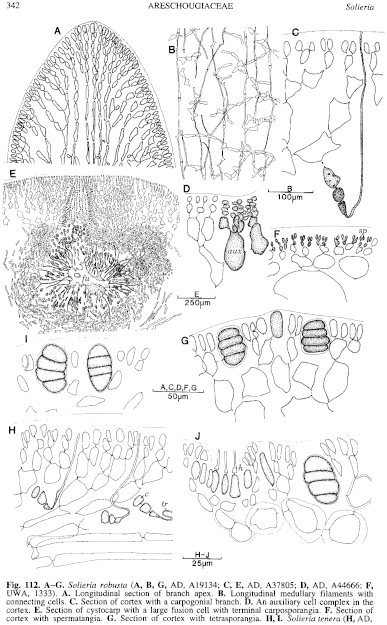|
|
|
|
|
|||||||||||
|
Electronic Flora of South Australia Species Fact Sheet
Phylum Rhodophyta – Class Florideophyceae – Order Gigartinales – Family Areschougiaceae
Selected citations: Gabrielson & Kraft 1984: 219, figs 1A, B, 2A, B. Fuhrer et al. 1981: pl. 63. Millar 1990: 345, fig. 21C. Min-Thein & Womersley 1976: 7, figs 1, 2, 49. Norris 1988: 103, figs 1, 2.
Synonyms
Dumontia robusta Greville 1830: 62.
Rhabdonia robusta (Greville) J. Agardh 1852: 355.
Solieria australis Harvey 1855a: 552; 1860b: pl. 149. Kützing 1869: 10, pl. 27.
Rhabdonia umbellata Zanardini 1874: 500.
Thallus (Fig. 111A) grey-red to brown-red, often bleached to yellow-grey, erect, 10–30 cm high, moderately and irregularly branched at intervals of 1–4 cm, branches relatively soft, terete to slightly compressed, (1–) 2–5 mm in diameter, basally constricted and tapering above to rounded or sub-acute tips. Holdfast fibrous, branched, 1–2 cm across, with several fronds; epilithic. Structure (Fig. 112A) multiaxial, with 5–15 apical cells, each subapical cell cutting off a single periaxial cell with successive periaxials orthostichous, developing a broad medulla of mainly longitudinal slender filaments (Fig. 112B) connected by short lateral filaments and with abundant rhizoids, and a pseudoparenchymatous cortex 5–6 cells thick, inner cells irregularly ovoid with numerous secondary pit-connections, 30–80 µm in diameter, outer cells 8–14 µm in diameter and LTD (1–) 1.5–2.5. Rhodoplasts elongate to ribbon shaped, several per cell.
Reproduction: Sexual thalli dioecious; non-procarpic. Carpogonial branches (Fig. 112C) 3 (–4)-celled, borne on an inner cortical cell and directed inwards, with a reflexed trichogyne, rarely with a sterile cell on the hypogynous cell. Connecting filament usually unbranched, non-septate (apart from adjacent to the carpogonium), uniting with the auxiliary cell (Fig. 112D) in a darker staining complex (visible prior to, or at least soon after, diploidization) of cortical cells, with adjacent cells cutting off branched chains of cells which contribute to the pericarp. Gonimoblast initial first developed inwardly and producing a compact group of cells, later gonimoblasts developed radially from the enlarging fusion cell (Fig. 112E) with terminal (and later subterminal), ovoid, carposporangia 15–25 µm in diameter and with some sterile gonimoblast filaments connected to the pericarp. Cystocarps single to clustered, immersed in the medulla and swelling the branch, with well-developed enveloping tissue of ovoid cells, ostiolate. Spermatangia (Fig. 112F) scattered on young branches, cut off from surface cortical cells, ovoid to tapering, 2–3 µm in diameter.
Tetrasporangia (Fig. 112G) scattered in the outer cortex, basally attached, ovoid, 30–45 µm long and 25–32 µm in diameter, zonately divided.
Type from "Nov. Ho11." (Fraser): holotype in E.
Selected specimens: 7 mile beach, N of Dongara, W. Aust., 1–2 m deep (Kirkman, 17.ix.1979; AD, A51312). Whitford Beach, Perth, W. Aust., 4–5 m deep (Lipkin, 6.ii.1982; AD, A52959). Cottesloe, W. Aust., drift (Pocock, 12.xii.1969; UWA, A1333). Middleton Beach, Albany, W. Aust., 0–1 m deep on jetty (Engler, 29.viii.1979; AD, A51324). Head of Great Australian Bight, S. Aust., upper sublittoral (Womersley, 4.ii.1954; AD, A19134). Ward I., S. Aust., 18–23 m deep (Shepherd, 13.iii.1980; AD, A50905). 5 km W of Tiparra Reef, S. Aust., 10 m deep (Owen, 2.iv.1971; AD, A38401). Northern Spencer Gulf, S. Aust., 9 m deep (Shepherd, 13.ix.1973; AD, A44183). Nora Creina, S. Aust., 2–3 m deep (Owen, 17.i.1971; AD, A37805). Dutton Bay, Portland, Vic., drift (Womersley, 13.iv.1959; AD, A22686). Off Black Rock, Port Phillip, Vic., 2 m deep (Macpherson, 19.iv.1959; AD, A24635). Crawfish Rock, Westernport Bay, Vic., upper sublittoral (Womersley, 16.i.1974; AD, A44666 -"Marine Algae of southern Australia" No. 157). Walkerville, Vic., drift (Sinkora A2078, 26.ii.1975; AD, A48418). Georgetown, Tas. (Harvey, Alg. Aust. Exsicc. 346J; AD, A43561).
Distribution: Recorded from Mauritius, South Africa, India, and the Philippines.
Dongara, W. Aust., around southern Australia and Tasmania to Townsville, Qld. Lord Howe I.
Taxonomic notes: Solieria robusta is a common alga under moderate to fairly turbulent water movement, extending from sheltered areas with strong current flow to shallow to deep water on rough-water coasts.
Formation of a sterile cell on the hypogynous cell of carpogonial branches is quite unusual, and the few connecting filaments observed have been septate only adjacent to the carpogonium and also unbranched.
Records from outside Australia still need detailed checking, since Japanese records have now been referred to a separate species, S. pacifica (Yamada) Yoshida 1989: 270.
References:
AGARDH, J.G. (1852). Species Genera et Ordines Algarum. Vol. 2, Part 2, pp. 337–720. (Gleerup: Lund.)
FUHRER, B., CHRISTIANSON, I.G., CLAYTON, M.N. & ALLENDER, B.M. (1981). Seaweeds of Australia. (Reed: Sydney.)
GABRIELSON, P.W. & KRAFT, G.T. (1984). The Marine Algae of Lord Howe Island (N.S.W.): the Family Solieriaceae (Gigartinales, Rhodophyta). Brunonia 7, 217–251.
GREVILLE, R.K. (1830). Algae Britannicae. (Maclachlan & Stewart: Edinburgh.)
HARVEY, W.H. (1855a). Some account of the marine botany of the colony of Western Australia. Trans. R. Ir. Acad. 22, 525–566.
HARVEY, W.H. (1860b). Phycologia Australica. Vol. 3, Plates 121–180. (Reeve: London.)
KÜTZING, F.T. (1869). Tabulae Phycologicae. Vol. 19. (Nordhausen.)
KYLIN, H. (1932). Die Florideenordnung Gigartinales. Lunds Univ. Årsskr. N.F. Avd. 2, 28 (8), 1–88, Plates 1–28.
MILLAR, A.J.K. (1990). Marine Red Algae of the Coffs Harbour Region, northern New South Wales. Aust. Syst. Bot. 3, 293–593.
MIN-THEIN, U. & WOMERSLEY, H.B.S. (1976). Studies on southern Australian taxa of Solieriaceae, Rhabdoniaceae and Rhodophyllidaceae (Rhodophyta). Aust. J. Bot. 24, 1–166.
NORRIS, R.E. (1988). A review of Natalian Solieriaceae (Gigartinales, Rhodophyta), including the first South African records of Solieria and Meristotheca, and an investigation of Erythroclonium corallinum. S. Afr. J. Bot. 54, 103–108.
YOSHIDA, T. (1989). Solieria pacifica (Yamada)Yoshida, comb. nov. (Solieriaceae, Rhodophyta) from Japan. Jap. J. Phycol. 37, 268–270.
ZANARDINI, J. (1874). Phyceae Australicae novae vel minus cognitae. Flora (Regensburg) 57, 486–490, 497–505.
The Marine Benthic Flora of Southern Australia Part IIIA complete list of references.
Publication:
Womersley, H.B.S. (14 January, 1994)
The Marine Benthic Flora of Southern Australia
Rhodophyta. Part IIIA, Bangiophyceae and Florideophyceae (to Gigartinales)
Reproduced with permission from The Marine Benthic Flora of Southern Australia Part IIIA 1994, by H.B.S. Womersley. Australian Biological Resources Study, Canberra. Copyright Commonwealth of Australia.
Illustrations in Womersley Part IIIA, 1994: FIGS 111 A, 112 A–G.

Figure 111 enlarge
Fig. 111. A. Solieria robusta (AD, A44666). Habit. B, C. Solieria tenera (AD, A42350). B. Habit. C. Section of cystocarp with fusion cell, gonimoblast filaments with carposporangia and ostiole. D, E. Sarconema filiforme (AD, A13695). D. Habit. E. Section of thallus with fusion cell, gonimoblast filaments and carposporangia.

Figure 112 enlarge
Fig. 112. A–G. Solieria robusta (A, B, G, AD, A19134; C, E, AD, A37805; D, AD, A44666; F, UWA, 1333). A. Longitudinal section of branch apex. B. Longitudinal medullary filaments with connecting cells. C. Section of cortex with a carpogonial branch. D. An auxiliary cell complex in the cortex. E. Section of cystocarp with a large fusion cell with terminal carposporangia. F. Section of cortex with spermatangia. G. Section of cortex with tetrasporangia. H, I. Solieria tenera (H, AD, A42350; I, MELU, 21966). H. Longitudinal section with medullary filaments and cortex with three carpogonial branches. I. Section of cortex with tetrasporangia. J. Sarconema filiforme (AD, A13695). Section of cortex with young and mature tetrasporangia and a hair tuft. [A–G after MM-Thein & Womersley 1976.]

|
Email Contact: State Herbarium of South Australia |

|